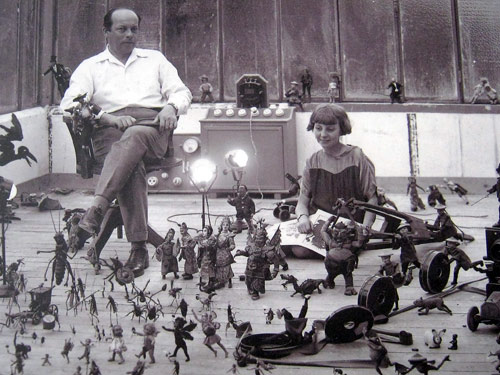行者 [Jingang Jing / Walker] (Tsai Ming-liang, 2012)
Dec
8
बोधि

The monk (Kang-sheng Lee) walking Hong Kong. DP: Tsai Ming-liang.
ShortFilm
Sioux Ghost Dance (William K.L. Dickson + William Heise 1894)
Dec
1
Hornbill Festival

A Sioux troupe – these particular people were part of Buffalo Bill’s Wild West show – perform a Ghost Dance in #ThomasEdison's Black Maria studio in New Jersey. DP: William Heise.
Indigenous dance for Hornbill Festival, Nagaland.
The End (Christopher Maclaine, 1953)
Nov
13
ice cream

A man suggestively licks an ice cream cone. DP: Jordan Belson.
“One grilled cheese, two slices of toast, two coffees. One pepper steak no chili and a plate of spaghetti and meatballs. Two glasses of milk. One plate of spare ribs. A chicken in a basket with three cups of honey. One lean smoked meat sandwich with pickles and mustard. One two-cream coffee and two club sandwiches. Two clubs.”Françoise Durocher, Waitress (André Brassard, 1972)
May
21
lunch break

Waitress Françoise Durocher, this may be Luce Guilbeault, on her lunch break. DP: Thomas Vámos.
– Françoise Durocher
Weegee’s Coney Island [Coney Island] (Arthur “Weegee” Fellig, 1954)
Feb
10
Good Humor

Two chubby ladies on Coney Island's beach eating chocolate-coated ice cream bars on a stick, I guess Good Humor bars. The women both wear black shapeless bathing suits. One of them has a pink towel over her shoulders and her hair in rollers. The framing shows only part of the couple, but tells you all you need to know. DP: Weegee.
Рождество обитателей леса (ca 1912)
Various beetles and a grasshopper rejoice around the Christmas tree materialised by Old Man Frost.
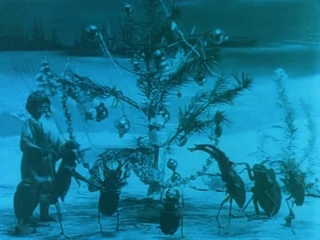
December 25: a Santa for #Christmas
Pождество обитателей леса [Rozhdestvo obitateley lesa / The Insects' Christmas] (Wladyslaw Starewicz, ca 1912)
Father Christmas makes a Christmas tree for the people of the forest.
Дед Мороз (Ded Moroz, or Old Man Frost) is the Slavic version of Saint Nicholas or Santa Claus. An ornament depicting the old grey climbs down a child's (or doll's) Christmas tree and sets off to the forest where he plants his magic staff to create a Christmas feast for the woodland animals.
The word “animation” means “a bestowing of life“. Like his ancestor in the arts Bernard Palissy and the ancient winter solstice celebration of the return of light that long ago spawned Christmas, Wladyslaw Starewicz's Insects' Christmas breathes life into real but inanimate beetles, dragonflies, and frogs. The illusion is complete as you effortlessly forget they are painstakingly animated.
From me to you, a little Christmas treat
Director Wladyslaw Starewicz and his daughter Irina (Irene), surrounded by several of his tiny actors. Irina, writer and director in her own right, starred in her father's WW1 short “Liliya Belgii” [“The Lily of Belgium”] (1915).
#Bales2023FilmChallenge #WladyslawStarewicz #Russia #fantasy #animation #ShortFilm #Christmas #holidays #StopMotion #insects #animals #1910s ★★★★☆
Colloque de chiens (1977)
Monique (Silke Humel, R) spending Christmas Eve in a bar, looking for a way out. She's speaking to an elderly man in an expensive tuxedo. Is this it? DP: Denis Lenoir; still photographer Patrice Morere.
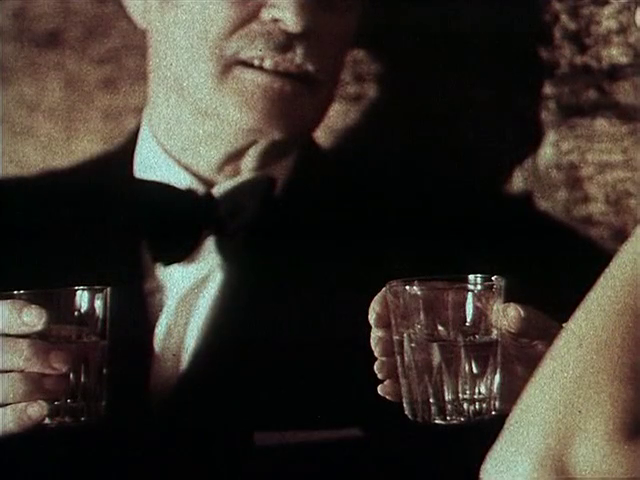
December 24: the night before Christmas (Christmas Eve)
Colloque de chiens (Raúl Ruiz, 1977)
“Nobody knows why Monique, the cold and dry voiced whore, bears in her eyes the sadness and tiredness of her past.”
Filmed during an actors' strike, Raúl Ruiz's Colloque de chiens consists for the most part of still photographs with mixed in stolen moving footage of unsuspecting bystanders and stray dogs. Told in fotonovela format, we follow the pitiful account of Monique, who as a young girl, learns that her mother is not who she thinks she is. Rejected, she throws herself into a life of vice until she meets Henri, a handsome young television repairman. Together they buy a small café, and are happy for once. But the cyclical nature of life determines her faith.
Raúl Ruiz's work is, like Henri's modus operandi, determined by maps and patterns. Even in the short comically melodramatic breathe of Colloque de chiens, the map has been laid out for Ruiz's later, much more complex narrative.
Colloque opens in a barren landscape. There are the skeletal towers of a nearby city, and the endless barks of abandoned dogs. Obscured by tall reeds, a blown-up photograph of a young man. The face, soft and familiar, a distant memory.
“He wanted to be returned to the world of his childhood and to this woman who was perhaps waiting for him” –Chris Marker, dialogue from La Jetée (1962)
Amongst bare winter bushes a large photo of a friendly, young, familiar looking man. In the background against a grey sky multiple white apartment buildings.

#Bales2023FilmChallenge #RaúlRuiz #SilkeHumel #EvaSimonet #RobertDarmel #JorgeArriagada #DenisLenoir #PatriceMorere #drama #crime #melodrama #ShortFilm #photography #animals #gender #prostitution #France #1970s ★★★★☆
“He's a peasant. Without looking into his situation, words are all he has.”شكاوى الفلاح الفصيح [El-Fallâh el-fasîh / The Eloquent Peasant] (Chadi Abdel Salam, 1970)
Dec
23
National Farmers Day – India
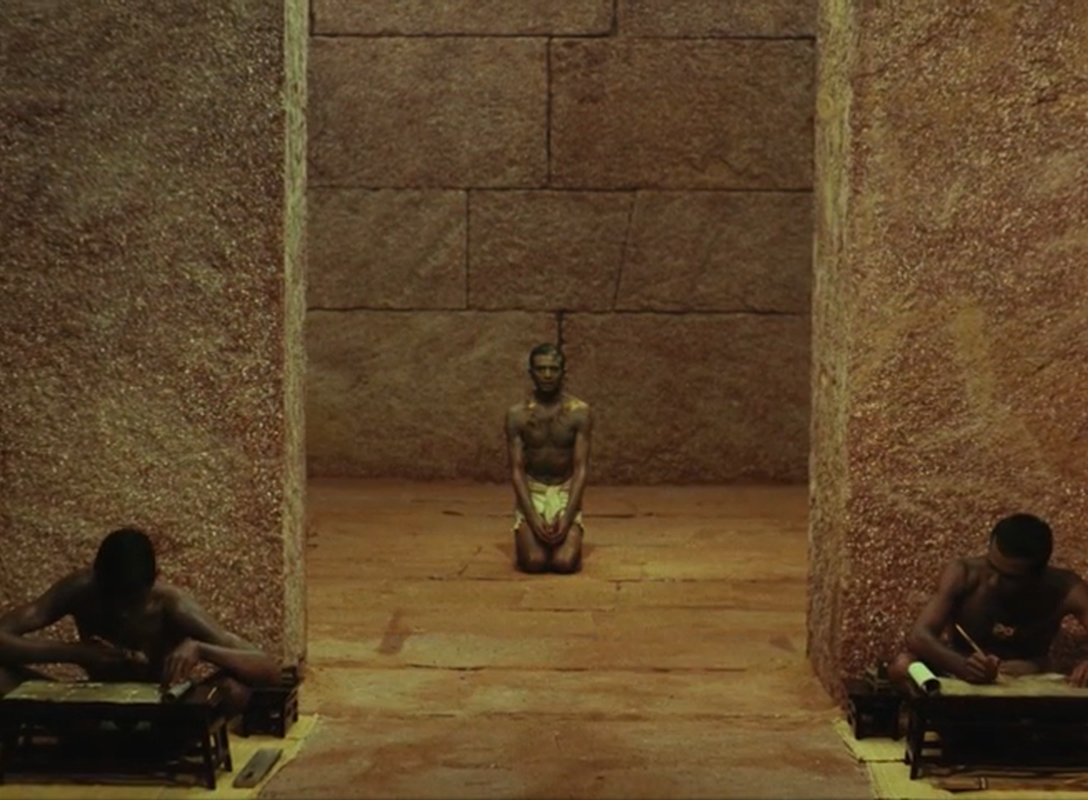
The peasant (Ahmed Marei) in a stone temple, flanked by scribes. DP: Mustafa Imam.
Farmers for Kisan Divas [National Farmers Day] (India)
4000 years ago, Egypt, Middle Kingdom. A peasant, leading his mules past a stream of water, is tricked. With his animals gone, he pleads to the Pharaoh to restore Maʽat, harmony.
Chadi Abdel Salam is not only this film's director, but also a trained architect, later set and costume designer. His eye wordlessly speaks the passing of time in the smallest of details. The withering of ferns, desert sand staining linen, the Sun merging with skin. At once, the universal presence of the gods becomes visible.
La perle [The Pearl] (Henri d'Ursel, 1929)
Dec
15
National Wear Your Pearls Day
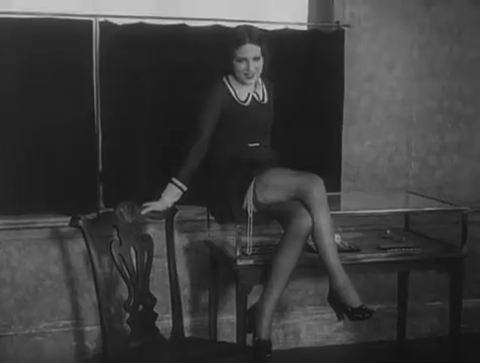
A giddy Kissa Kouprine as the jewellery salesgirl. A pearl necklace jauntily dangles from her suspender. DP: Marc Bujard.
Pearls worn for National Wear Your Pearls Day (USA). No one said those pearls were to be worn in the obvious place.
“Inflammable desires dampened by day under the cold water of consciousness are ignited that night by the libertarian matches of sleep, and burst forth in showers of shimmering incandescence.”Fireworks (Kenneth Anger, 1947)
Dec
8
National Christmas Tree Day
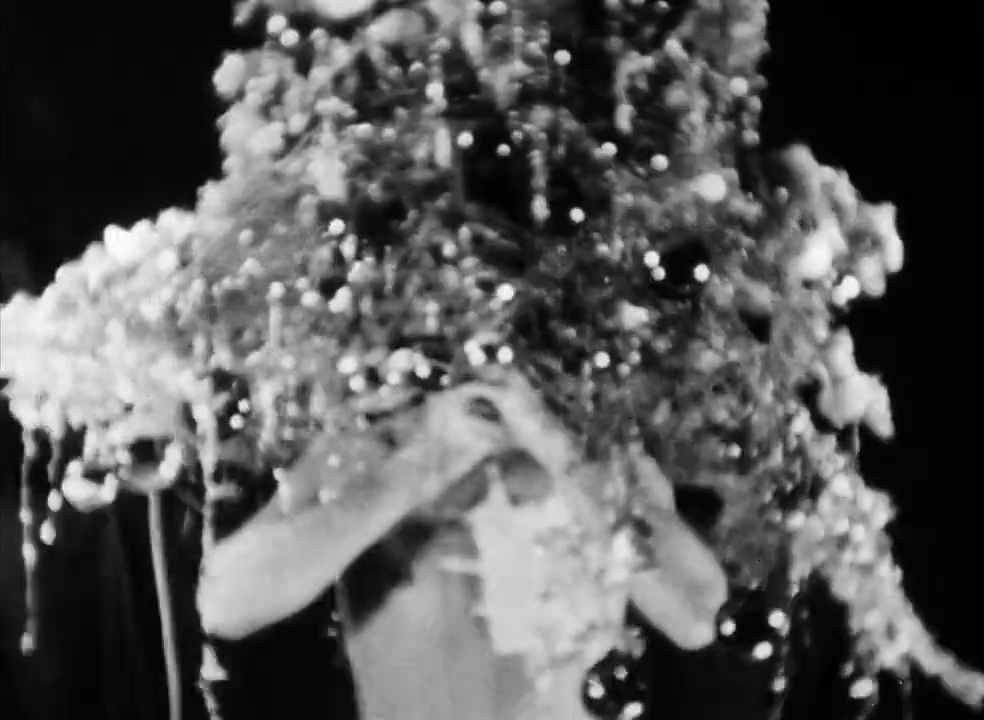
The Dreamer (Kenneth Anger) holding a tinsel-decked Christmas tree in front of his naked upper body. The scene appears to foreshadow Yvonne Marquis getting into her silver dress in Anger's Puce Moment (1949).
A Christmas tree for National Christmas Tree Day (USA)
In August 1942, a Mexican-American man with a broken finger was found semiconscious near Sleepy Lagoon, Ca.. By association, a group of young Latinos was put on trial. This spark, mere months after Roosevelt sent thousands of Japanese Americans to concentration camps and fuelled by Cold War paranoia, eventually set off the Zoot Suit Riots.
Zoot Suiters or Pachucos and other “outsiders” like African, Italian and Filipino Americans, were viciously attacked by Anglo-American #sailors. Those suits, all that fabric, this colourful extravagance, they cried out, were hampering the war effort.
– The Dreamer
The Dreamer, Anger, dreams of a similar violent attack. The sadism is harrowing, filmed with such exquisite eye that it's impossible to look away. Blood finds its way out, pulsating and spurting. Ambiguous glances. A hand, no finger. A young man awakes, is born. The dreamer is still asleep.
